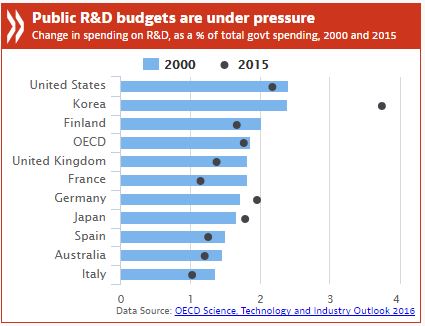A decline in government funding of science and technology research in a number of countries could pose a threat to innovation at a time when global challenges like climate change and ageing populations demand solutions, according to a new OECD report.
The OECD Science, Technology and Innovation Outlook 2016 warns that a backlash against globalisation and migration in some countries could also become a cause for concern given that innovation is increasingly driven by cross-border cooperation and the ability of scientists, students and entrepreneurs to move about and work in different countries over their careers.
 Spending on research and development in government and higher education institutions in OECD countries fell in 2014 for the first time since the data were first collected in 1981, the report says. R&D spending in government and higher education labs, most of which is provided by governments, began flattening out in 2010 following three decades of growth.
Spending on research and development in government and higher education institutions in OECD countries fell in 2014 for the first time since the data were first collected in 1981, the report says. R&D spending in government and higher education labs, most of which is provided by governments, began flattening out in 2010 following three decades of growth.
A separate indicator, total R&D spending by governments – most of which is carried out by public entities but may also be done by the private sector funded by public grants – is receding in many countries as other policy priorities such as state pensions, health and social care are absorbing a growing share of public resources.
Data on the percentage of government budgets dedicated to R&D for 2000 and 2015 show that while countries like Germany, Japan and Korea are spending more now on R&D than in 2000 as a share of total expenses, others including Australia, Finland, France, Italy, Spain, the UK and the US have reduced their R&D efforts. Total government spending on R&D in the OECD area has been declining since 2009, following the global financial crisis.
| “Economic growth depends on innovation, and innovation will be vital to solve the big global headaches of the 21st Century from ageing populations and dementia to climate change and inequality,” said OECD Science, Technology and Innovation Director Andrew Wyckoff. “Maintaining public funding of R&D, open science and international mobility for researchers is absolutely fundamental for the future of innovation and our future in general.”
The report says government funding of R&D is likely to plateau at current levels or decline further given pressure on public finances in many countries and sluggish economic growth. A tendency among governments to focus more on offering R&D tax incentives to firms than funding R&D in universities and public laboratories is also tilting the balance towards the private sector. That can mean funds are allocated to where new products or profits are most likely rather than to less directly focused research which is often the source of unexpected breakthroughs. Business R&D tends to favour development over pure research. |
Although they carry out less than 30% of total R&D in the OECD area, universities and public research institutes perform more than three-quarters of basic research. They often undertake longer-term and higher-risk research, as well as the kind of projects that have more potential to translate into tangible societal benefits. Artificial intelligence and personalised medicine are two examples of innovations that came about thanks to scientific and technological developments enabled by public research.
Key findings of the report include:
- Over a third of the research done globally in government and higher education institutions takes place in non-OECD economies. China spent around twice as much on public R&D as Japan in 2014. India, Russia, Chinese Taipei, Iran and Argentina have some of the world’s biggest public science systems.
- Five countries – the US, China, Japan, Germany and India – accounted for 59% of global public R&D in 2014, while 25 countries were behind 90% of the total. This dominance by a few partly reflects their large size. In the future, economies with fast-growing populations and GDP, as in Africa, may become more important players.
- Charities, foundations and philanthropists have become increasingly prominent funders of university research in recent years, particularly in the area of health where they often fund research into rare or tropical diseases. This will have an impact on future public research agendas.
- Different countries currently have different specialisations: for example health and medical science takes up 24% of public R&D spending in the US, 22% in the UK and 17% in Canada while energy R&D is 19% of the total in Mexico, 11% in Japan and 9% in Korea. Country priorities are changing and increasingly reflect the growing societal challenges mentioned above such as climate change and demographics.
Read the report along with 50 individual country profiles and 40 policy profiles:
www.oecd.org/innovation/oecd-science-technology-and-innovation-outlook-25186167.htm
Source: OECD